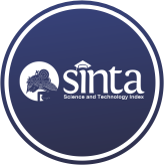Application of Learning Rate in Artificial Neural Networks to Increase Prediction Accuracy on Rubber Tree Maintenance Costs
(1) Universitas Bina Sarana Informatika, Indonesia
(2) Universitas Bina Sarana Informatika, Indonesia
(3) Universitas Bina Sarana Informatika, Indonesia
(4) Universitas Nusa Mandiri, Jakarta, Indonesia
(5) Universitas Bina Sarana Informatika, Indonesia
(*) Corresponding Author
Abstract
Full Text:
PDFReferences
N. K. Sharma, “Enhancing Infrastructure Sustainability: Reliability And Sensitivity Analysis Of Localized Integrated Renewable Energy Systems Using Feed Forward Backpropagation Neural Network,” Int. J. Adv. Technol. Eng. Explor., Vol. 11, No. 110, Pp. 58–75, 2024, Doi: 10.19101/Ijatee.2022.10100447.
A. Pal, “Machine Learning Models For Predicting Compressive Strength Of Fiber-Reinforced Concrete Containing Waste Rubber And Recycled Aggregate,” J. Clean. Prod., Vol. 423, 2023, Doi: 10.1016/J.Jclepro.2023.138673.
B. H. Trisasongko, “Rural Land Cover Mapping Using Short-Term Sentinel-2 Temporal Composites And Machine Learning,” J. Appl. Remote Sens., Vol. 17, No. 2, 2023, Doi: 10.1117/1.Jrs.17.024517.
Y. Liu, “Evaluation Of Aging And Degradation For Silicone Rubber Composite Insulator Based On Machine Learning,” J. Phys. D. Appl. Phys., Vol. 56, No. 42, 2023, Doi: 10.1088/1361-6463/Ace78c.
X. Yan, “An Ensemble Machine Learning Method For Microplastics Identification With Ftir Spectrum,” J. Environ. Chem. Eng., Vol. 10, No. 4, 2022, Doi: 10.1016/J.Jece.2022.108130.
N. Somching, “Using Machine Learning Algorithm And Landsat Time Series To Identify Establishment Year Of Para Rubber Plantations: A Case Study In Thalang District, Phuket Island, Thailand,” Int. J. Remote Sens., Vol. 41, No. 23, Pp. 9075–9100, 2020, Doi: 10.1080/01431161.2020.1799450.
J. F. Pei, “Backpropagation Neural Network-Based Survival Analysis For Breast Cancer Patients,” Int. J. Radiat. Res., Vol. 22, No. 1, Pp. 163–169, 2024, Doi: 10.52547/Ijrr.22.1.23.
A. Yaqin, “Evaluation Of Backpropagation Neural Network Models For Early Prediction Of Student’s Graduation In Xyz University,” Int. J. Adv. Sci. Eng. Inf. Technol., Vol. 11, No. 2, Pp. 610–617, 2021, Doi: 10.18517/Ijaseit.11.2.11152.
S. L. B. Ginting, “Data Mining, Neural Network Algorithm To Predict Student’s Grade Point Average: Backpropagation Algorithm,” J. Eng. Sci. Technol., Vol. 16, No. 3, Pp. 2028–2037, 2021.
B. Aprilia, “Performance Of Backpropagation Artificial Neural Network To Predict El Nino Southern Oscillation Using Several Indexes As Onset Indicators,” J. Phys. Conf. Ser., Vol. 1876, No. 1, 2021, Doi: 10.1088/1742-6596/1876/1/012004.
P. Alkhairi, W. Wanayumini, And B. H. Hayadi, “Analysis Of The Adaptive Learning Rate And Momentum Effects On Prediction Problems In Increasing The Training Time Of The Backpropagation Algorithm,” Aip Conf. Proc., Vol. 3048, No. 1, P. 20049, 2024, Doi: 10.1063/5.0203374.
P. Alkhairi And Z. Situmorang, “Penerapan Data Mining Untuk Menganalisis Kepuasan Pegawai Terhadap Pelayanan Bidang Sdm Dengan Algoritma C4.5,” Jurasik (Jurnal Ris. Sist. Inf. Dan Tek. Inform., Vol. 7, No. 1, P. 40, 2022, Doi: 10.30645/Jurasik.V7i1.414.
A. P. Windarto, T. Herawan, And P. Alkhairi, “Prediction Of Kidney Disease Progression Using K-Means Algorithm Approach On Histopathology Data,” In Artificial Intelligence, Data Science And Applications, Y. Farhaoui, A. Hussain, T. Saba, H. Taherdoost, And A. Verma, Eds., Cham: Springer Nature Switzerland, 2024, Pp. 492–497.
P. Alkhairi, L. P. Purba, A. Eryzha, A. P. Windarto, And A. Wanto, “The Analysis Of The Electree Ii Algorithm In Determining The Doubts Of The Community Doing Business Online,” In Journal Of Physics: Conference Series, 2019, P. 12010.
S. Defit, A. P. Windarto, And P. Alkhairi, “Comparative Analysis Of Classification Methods In Sentiment Analysis: The Impact Of Feature Selection And Ensemble Techniques Optimization,” Telematika, Vol. 17, No. 1, Pp. 52–67, 2024.
P. Alkhairi, A. P. Windarto, And H. S. Tambunan, “Analisis Menentukan Daerah Potensi Terbaik Dalam Pengembangan Wilayah Sektor Unggulan Pertanian Menggunakan Metode Ahp,” In Seminar Nasional Sains Dan Teknologi Informasi (Sensasi), 2018.
P. Alkhairi, I. S. Damanik, And A. P. Windarto, “Penerapan Jaringan Saraf Tiruan Untuk Mengukur Korelasi Beban Kerja Dosen Terhadap Peningkatan Jumlah Publikasi,” Pros. Semin. Nas. Ris. Inf. Sci., Vol. 1, No. September, P. 581, 2019, Doi: 10.30645/Senaris.V1i0.65.
K. V. Rani, “Lung Lesion Classification Scheme Using Optimization Techniques And Hybrid (Knn-Svm) Classifier,” Iete J. Res., Vol. 68, No. 2, Pp. 1485–1499, 2022, Doi: 10.1080/03772063.2019.1654935.
Y. Li, J. Zhang, T. Li, H. Liu, J. Li, And Y. Wang, “Geographical Traceability Of Wild Boletus Edulis Based On Data Fusion Of Ft-Mir And Icp-Aes Coupled With Data Mining Methods (Svm),” Spectrochim. Acta - Part A Mol. Biomol. Spectrosc., Vol. 177, Pp. 20–27, 2017, Doi: 10.1016/J.Saa.2017.01.029.
R. Kadry And O. Ismael, “A New Hybrid Knn Classification Approach Based On Particle Swarm Optimization,” Int. J. Adv. Comput. Sci. Appl., Vol. 11, No. 11, Pp. 291–296, 2020, Doi: 10.14569/Ijacsa.2020.0111137.
Z. A. Sejuti And M. S. Islam, “A Hybrid Cnn–Knn Approach For Identification Of Covid-19 With 5-Fold Cross Validation,” Sensors Int., Vol. 4, No. November 2022, P. 100229, 2023, Doi: 10.1016/J.Sintl.2023.100229.
P. Alkhairi And Z. Situmorang, “Application Of Data Mining To Analyze Employee Satisfaction With Hr Services With The C4. 5 Algorithm,” Jurasik (Jurnal Ris. Sist. Inf. Dan Tek. Inf., Vol. 7, No. 1, P. 40, 2022.
I. Irvanizam, “Applying Artificial Neural Network Based On Backpropagation Method For Indonesian Sign Language Recognition,” Int. J. Comput. Digit. Syst., Vol. 14, No. 1, Pp. 975–985, 2023, Doi: 10.12785/Ijcds/140176.
I. Ranggadara, U. M. Buana, A. Ratnasari, And U. M. Buana, “Backpropagation Neural Network For Predict Sugarcane Stock Availability,” Int. J. Adv. Trends Comput. Sci. Eng., Vol. 9, No. 5, Pp. 8279–8284, 2020, Doi: 10.30534/Ijatcse/2020/197952020.
X. Y. Huang Et Al., “Compressive Strength Prediction Of Rubber Concrete Based On Artificial Neural Network Model With Hybrid Particle Swarm Optimization Algorithm,” Materials (Basel)., Vol. 15, No. 11, 2022, Doi: 10.3390/Ma15113934.
S. R. Dani, S. Solikhun, And D. Priyanto, “The Performance Machine Learning Powel-Beale For Predicting Rubber Plant Production In Sumatera,” Int. J. Eng. Comput. Sci. Appl., Vol. 2, No. 1, Pp. 29–38, 2023, Doi: 10.30812/Ijecsa.V2i1.2420.
A. P. Windarto, I. R. Rahadjeng, M. N. H. Siregar, And P. Alkhairi, “Deep Learning To Extract Animal Images With The U-Net Model On The Use Of Pet Images,” J. Media Inform. Budidarma, Vol. 8, No. 1, Pp. 468–476, 2024.
DOI: https://doi.org/10.30645/kesatria.v5i4.467
DOI (PDF): https://doi.org/10.30645/kesatria.v5i4.467.g462
Refbacks
- There are currently no refbacks.
Published Papers Indexed/Abstracted By:














